Effects of Lithium Slag on the Frost Resistance of Cement-Soil
Abstract
:1. Introduction
2. Materials and Methods
2.1. Materials
2.2. Mix Proportion
2.3. Preparation Process
2.4. Test Methods
2.4.1. Freeze–Thaw Cycles Test
2.4.2. Unconfined Compression Strength Test
2.4.3. Triaxial Compression Test
2.4.4. NMR Test
2.4.5. SEM Test
3. Results and Discussion
3.1. Frost Resistance Analysis
3.2. Unconfined Compression Strength Ansysis
3.3. Triaxial Shear Test Ansysis
3.3.1. Stress–Strain Curve
3.3.2. Cohesion and Internal Friction Angle
3.4. Microscopic Analysis
3.4.1. NMR T2 Distribution Analysis
3.4.2. SEM Analysis
4. Performance Improvement Principle
5. Conclusions
- The degree of surface damage of the cement-soil specimens with different LS contents varied after 4 freeze–thaw cycles. The incorporation of LS suppressed the propagation of freeze–thaw damage cracks on the surface of the specimens, and the damage area was also reduced. By testing the mass change in the specimens before and after freeze–thaw cycles, it is found that the mass loss values of the specimen groups incorporated with LS were less than those of the groups without LS incorporated.
- LS can also improve the unconfined compression strength and shear strength of cement-soil. The strength values of cement-soil with LS are higher than those without LS under 0, 2, and 4 freeze–thaw cycles, and the strength value increases most obviously when the content of LS is 12%.
- The effect of LS incorporation on the cohesion and internal friction angle of the cement-soil was also significant, in which the cohesion was the key to the improvement in the performance of the cement-soil, and the cohesion of the specimen group with 12% LS incorporation after 4 freeze–thaw cycles was increased by 1.1 MPa compared with that of the specimen group without LS incorporation.
- The incorporation of LS effectively reduces the porosity and pore size inside the cement-soil, and the relatively high content of . and in LS with a certain degree of pozzolanic activity can generate gels such as C-S-H by secondary hydration reaction inside the cement-soil, which helps to increase the bonding skeleton inside the cement-soil, and thus resist the crack growth under the freeze–thaw action.
Author Contributions
Funding
Institutional Review Board Statement
Informed Consent Statement
Data Availability Statement
Conflicts of Interest
References
- Jin, Q.; Cui, X.; Su, J.; Lu, T.; Wang, J.; Han, R. Laboratory Measurement and Analysis of the Deteriorated Layer Permeability Coefficient of Soil-Cement Deteriorated in a Saline Environment. Materials 2019, 12, 2245. [Google Scholar] [CrossRef] [PubMed]
- Li, F.R.; Sun, H.C. Experimental Study and Mechanism Analysis of the Mechanical Property of Cement Soil with Different Straws. Chem. Eng. Trans. 2016, 51, 1069–1074. [Google Scholar] [CrossRef]
- Wang, S.; Chen, F.; Xue, Q.; Zhang, P. Splitting Tensile Strength of Cement Soil Reinforced with Basalt Fibers. Materials 2020, 13, 3110. [Google Scholar] [CrossRef] [PubMed]
- Linares-Unamunzaga, A.; Pérez-Acebo, H.; Rojo, M.; Gonzalo-Orden, H. Flexural Strength Prediction Models for Soil–Cement from Unconfined Compressive Strength at Seven Days. Materials 2019, 12, 387. [Google Scholar] [CrossRef] [PubMed]
- Ezreig, A.M.A.; Mohamad Ismail, M.A.; Ehwailat, K.I.A. Hydrophobic Effect of Soil Stabilization for a Sustainable Subgrade Soil Improvement. Materials 2022, 15, 3087. [Google Scholar] [CrossRef] [PubMed]
- Zhang, G.; Ding, Z.; Wang, Y.; Fu, G.; Wang, Y.; Xie, C.; Zhang, Y.; Zhao, X.; Lu, X.; Wang, X. Performance Prediction of Cement Stabilized Soil Incorporating Solid Waste and Propylene Fiber. Materials 2022, 15, 4250. [Google Scholar] [CrossRef] [PubMed]
- Bai, S.G.; Hou, Y.F. Study on Properties of Cement Lime-Fly-Ash Soil. Key Eng. Mater. 2006, 302–303, 457–461. [Google Scholar] [CrossRef]
- Wang, F.; Ping, X.; Zhou, J.; Kang, T. Effects of Crumb Rubber on the Frost Resistance of Cement-Soil. Constr. Build. Mater. 2019, 223, 120–132. [Google Scholar] [CrossRef]
- Zhang, Y.; Johnson, A.E.; White, D.J. Laboratory Freeze–Thaw Assessment of Cement, Fly Ash, and Fiber Stabilized Pavement Foundation Materials. Cold Reg. Sci. Technol. 2016, 122, 50–57. [Google Scholar] [CrossRef]
- Chai, M.; Zhang, J. Improvement of Compressibility and Thaw-Settlement Properties of Warm and Ice-Rich Frozen Soil with Cement and Additives. Materials 2019, 12, 1068. [Google Scholar] [CrossRef]
- Jamshidi, R.J.; Lake, C.B.; Gunning, P.; Hills, C.D. Effect of Freeze/Thaw Cycles on the Performance and Microstructure of Cement-Treated Soils. J. Mater. Civ. Eng. 2016, 28, 04016162. [Google Scholar] [CrossRef]
- Wang, F.C.; Li, P.F.; Ye, X.P. Effects of Salt Corrosion and Freeze-Thaw Cycle on Rubberized Cement-Soil. Adv. Mater. Res. 2010, 152–153, 967–972. [Google Scholar] [CrossRef]
- Wen, Y.Q.; Cui, C. Experimental Study on the Additive Effects of Cyclic Freezing-Thawing on the Durability of Cement Soil. Appl. Mech. Mater. 2014, 507, 363–367. [Google Scholar] [CrossRef]
- Widjajakusuma, J.; Winata, H. Influence of Rice Husk Ash and Clay in Stabilization of Silty Soils Using Cement. In MATEC Web of Conferences; EDP Sciences: Ulis, France, 2017; Volume 138, p. 04004. [Google Scholar] [CrossRef]
- Chen, F.; Tong, S. Effect of Ferronickel Slag Powder on Strength of Soil in Marine Environment. Adv. Civ. Eng. 2020, 2020, 8856055. [Google Scholar] [CrossRef]
- Wen, Y.Q.; Feng, X.Y.; Shen, X.D.; Cui, Y.P. Microscopic Mechanism Study on the Strength Effects of Pumice Powder to Cement Soil. Adv. Mater. Res. 2013, 834–836, 776–783. [Google Scholar] [CrossRef]
- Wen, Y.Q.; Shen, X.D.; Cui, C. Experimental Study on the Mechanical Performance of Pumice Powder Cement Soil. Appl. Mech. Mater. 2014, 507, 383–387. [Google Scholar] [CrossRef]
- Zhang, Y.; Johnson, A.E.; White, D.J. Freeze-Thaw Performance of Cement and Fly Ash Stabilized Loess. Transp. Geotech. 2019, 21, 100279. [Google Scholar] [CrossRef]
- Xu, L.; Niu, L. Effect of Polypropylene Fiber on Frost Resistance of Cemented Soil. Mater. Plast. 2019, 57, 78–86. [Google Scholar] [CrossRef]
- Li, H.F.; Xia, Y. The Frost Resistance of High Strength Concrete Containing Super-Fine Mineral Admixture. Adv. Mater. Res. 2012, 512–515, 2999–3002. [Google Scholar] [CrossRef]
- Wang, X.; Hu, H.; Liu, M.; Li, Y.; Tang, Y.; Zhuang, L.; Tian, B. Comprehensive Utilization of Waste Residue from Lithium Extraction Process of Spodumene. Miner. Eng. 2021, 170, 106986. [Google Scholar] [CrossRef]
- He, Z.; Li, L.; Du, S. Mechanical Properties, Drying Shrinkage, and Creep of Concrete Containing Lithium Slag. Constr. Build. Mater. 2017, 147, 296–304. [Google Scholar] [CrossRef]
- Tan, H.; Zhang, X.; He, X.; Guo, Y.; Deng, X.; Su, Y.; Yang, J.; Wang, Y. Utilization of Lithium Slag by Wet-Grinding Process to Improve the Early Strength of Sulphoaluminate Cement Paste. J. Clean. Prod. 2018, 205, 536–551. [Google Scholar] [CrossRef]
- Tan, H.; Li, X.; He, C.; Ma, B.; Bai, Y.; Luo, Z. Utilization of Lithium Slag as an Admixture in Blended Cements: Physico-Mechanical and Hydration Characteristics. J. Wuhan Univ. Technol.-Mater. Sci Ed. 2015, 30, 129–133. [Google Scholar] [CrossRef]
- Liu, Z.; Wang, J.; Jiang, Q.; Cheng, G.; Li Li; Kang, Y.; Wang, D. A Green Route to Sustainable Alkali-Activated Materials by Heat and Chemical Activation of Lithium Slag. J. Clean. Prod. 2019, 225, 1184–1193. [Google Scholar] [CrossRef]
- Ali Shah, S.F.; Chen, B.; Ahmad, M.R.; Haque, M.A. Development of Cleaner One-Part Geopolymer from Lithium Slag. J. Clean. Prod. 2021, 291, 125241. [Google Scholar] [CrossRef]
- Yiren, W.; Dongmin, W.; Yong, C.; Dapeng, Z.; Ze, L. Micro-Morphology and Phase Composition of Lithium Slag from Lithium Carbonate Production by Sulphuric Acid Process. Constr. Build. Mater. 2019, 203, 304–313. [Google Scholar] [CrossRef]
- He, Z.; Du, S.; Chen, D. Microstructure of Ultra High Performance Concrete Containing Lithium Slag. J. Hazard. Mater. 2018, 353, 35–43. [Google Scholar] [CrossRef]
- Wu, F.F.; Shi, K.B.; Dong, S.K. Properties and Microstructure of HPC with Lithium-Slag and Fly Ash. Key Eng. Mater. 2014, 599, 70–73. [Google Scholar] [CrossRef]
- Li, J.; Huang, S. Recycling of Lithium Slag as a Green Admixture for White Reactive Powder Concrete. J. Mater. Cycles Waste Manag. 2020, 22, 1818–1827. [Google Scholar] [CrossRef]
- Park, C.-G.; Yun, S.-W.; Baveye, P.; Yu, C. Effect of Industrial By-Products on Unconfined Compressive Strength of Solidified Organic Marine Clayey Soils. Materials 2015, 8, 5098–5111. [Google Scholar] [CrossRef]
- Shi, J.; Wang, S.; Cao, W.; Su, J.; Zhang, X. Mechanical Properties and Strengthening Mechanism of Dredged Silty Clay Stabilized by Cement and Steel Slag. Materials 2022, 15, 3823. [Google Scholar] [CrossRef] [PubMed]
- Shi, K.B.; Zhang, S.D. Ring Method Test on the Early-Age Anti-Cracking Capability of High-Performance Lithium Slag Concrete. Appl. Mech. Mater. 2011, 94–96, 782–785. [Google Scholar] [CrossRef]
- Qin, Y.; Chen, J.; Liu, K.; Lu, Y. Durability properties of recycled concrete with lithium slag under freeze-thaw cycles. Mater. Tehnol. 2021, 55, 171–181. [Google Scholar] [CrossRef]
- Wang, W.; Fu, Y.; Zhang, C.; Li, N.; Zhou, A. Mathematical Models for Stress–Strain Behavior of Nano Magnesia-Cement-Reinforced Seashore Soft Soil. Mathematics 2020, 8, 456. [Google Scholar] [CrossRef]
- Long, G.; Li, L.; Li, W.; Ma, K.; Dong, W.; Bai, C.; Zhou, J.L. Enhanced Mechanical Properties and Durability of Coal Gangue Reinforced Cement-Soil Mixture for Foundation Treatments. J. Clean. Prod. 2019, 231, 468–482. [Google Scholar] [CrossRef]
- Zhang, Z.Q.; Jing, Y.L. Mechanical Properties of Road Base with Roadbood EN-1. Adv. Mater. Res. 2011, 255–260, 3366–3370. [Google Scholar] [CrossRef]
- Nasrollahzadeh, K.; Nouhi, E. Fuzzy Inference System to Formulate Compressive Strength and Ultimate Strain of Square Concrete Columns Wrapped with Fiber-Reinforced Polymer. Neural Comput. Appl. 2018, 30, 69–86. [Google Scholar] [CrossRef]
- Li, N.; Zhu, Q.; Wang, W.; Song, F.; An, D.; Yan, H. Compression Characteristics and Microscopic Mechanism of Coastal Soil Modified with Cement and Fly Ash. Materials 2019, 12, 3182. [Google Scholar] [CrossRef]
- Tan, H.; Li, M.; He, X.; Su, Y.; Zhang, J.; Pan, H.; Yang, J.; Wang, Y. Preparation for Micro-Lithium Slag via Wet Grinding and Its Application as Accelerator in Portland Cement. J. Clean. Prod. 2020, 250, 119528. [Google Scholar] [CrossRef]
- Zhao, A.P.; Tang, A.P.; Sun, J.; Yu, X.M. Tests and Research on Characteristics of Shear Strength of Cement Improved Soil under Freeze-Thaw Cycle. Adv. Mater. Res. 2014, 1015, 105–109. [Google Scholar] [CrossRef]
- Gao, F.; Tian, W.; Cheng, X. Investigation of Moisture Migration of MWCNTs Concrete after Different Heating-Cooling Process by LF-NMR. Constr. Build. Mater. 2021, 288, 123146. [Google Scholar] [CrossRef]
- Liu, H.; Sun, Z.; Yang, J.; Ji, Y. A Novel Method for Semi-Quantitative Analysis of Hydration Degree of Cement by 1H Low-Field NMR. Cem. Concr. Res. 2021, 141, 106329. [Google Scholar] [CrossRef]
- Wang, S.; He, X.; Cai, G.; Lang, L.; Ma, H.; Gong, S.; Niu, Z. Investigation on Water Transformation and Pore Structure of Cement-Stabilized Dredged Sediment Based on NMR Technology. Materials 2022, 15, 3178. [Google Scholar] [CrossRef]
- Wang, X.; Shen, X.; Wang, H.; Gao, C.; Zhang, T. Nuclear Magnetic Resonance Analysis of Freeze-Thaw Damage in Natural Pumice Concrete. Mater. Constr. 2016, 66, e087. [Google Scholar] [CrossRef]
- Juenger, M.C.G.; Winnefeld, F.; Provis, J.L.; Ideker, J.H. Advances in Alternative Cementitious Binders. Cem. Concr. Res. 2011, 41, 1232–1243. [Google Scholar] [CrossRef]
- Bullard, J.W.; Jennings, H.M.; Livingston, R.A.; Nonat, A.; Scherer, G.W.; Schweitzer, J.S.; Scrivener, K.L.; Thomas, J.J. Mechanisms of Cement Hydration. Cem. Concr. Res. 2011, 41, 1208–1223. [Google Scholar] [CrossRef]
- Narloch, P.; Woyciechowski, P.; Kotowski, J.; Gawriuczenkow, I.; Wójcik, E. The Effect of Soil Mineral Composition on the Compressive Strength of Cement Stabilized Rammed Earth. Materials 2020, 13, 324. [Google Scholar] [CrossRef]
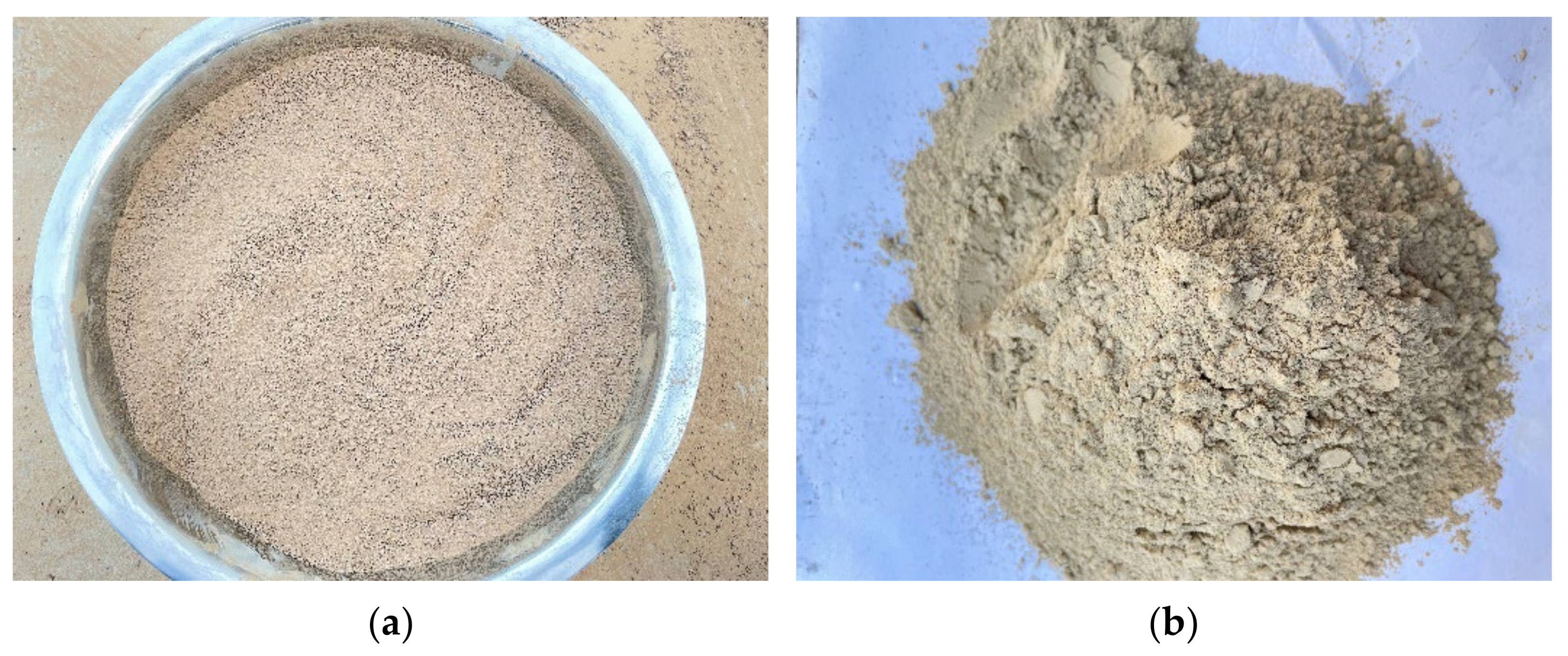

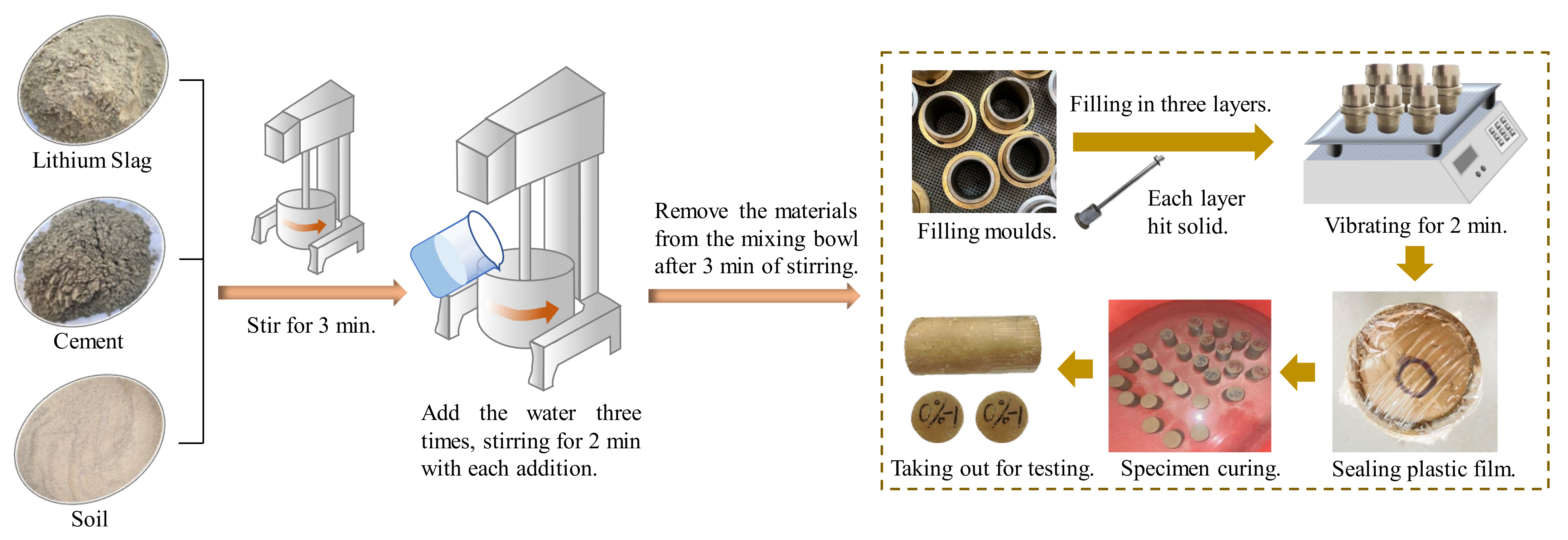
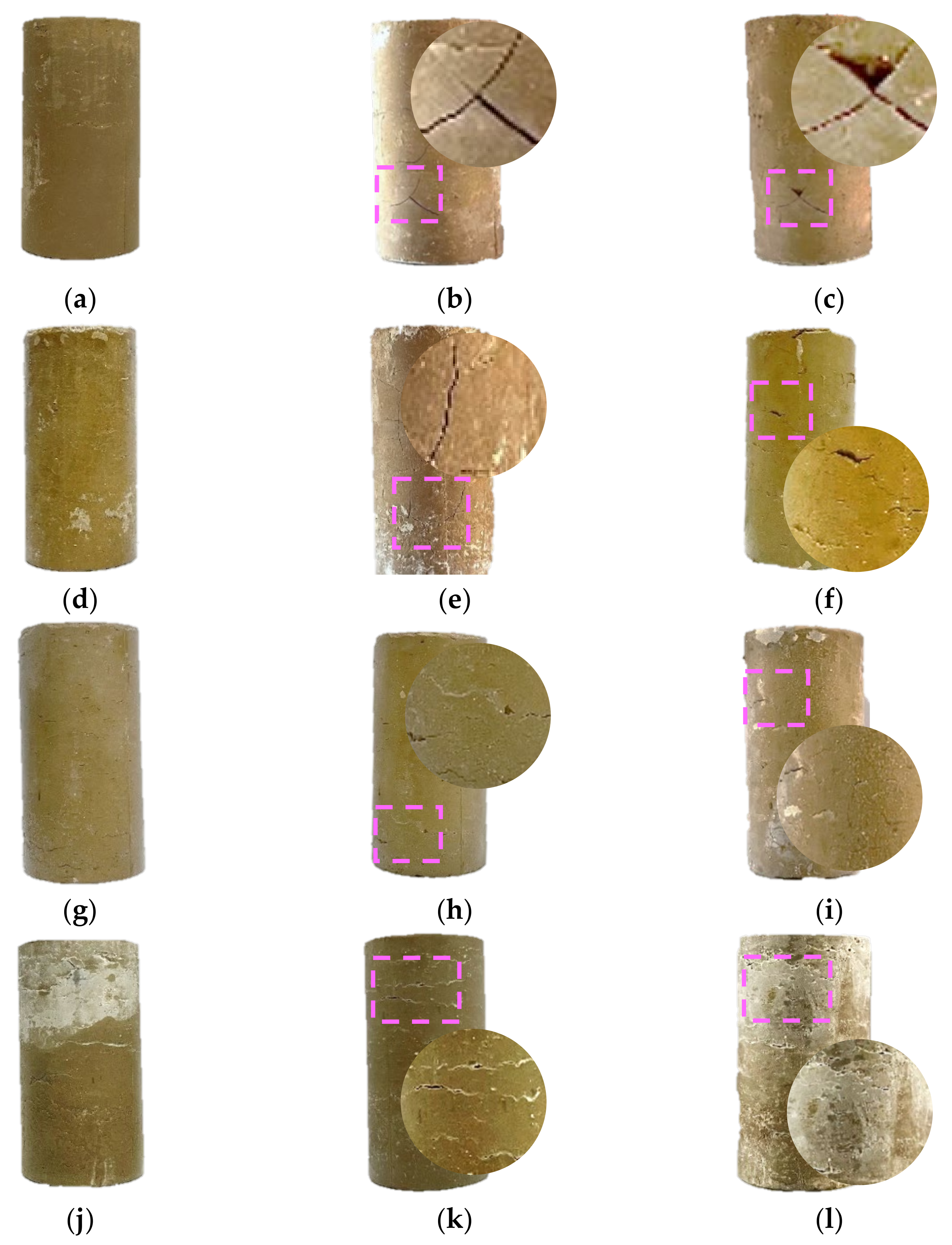


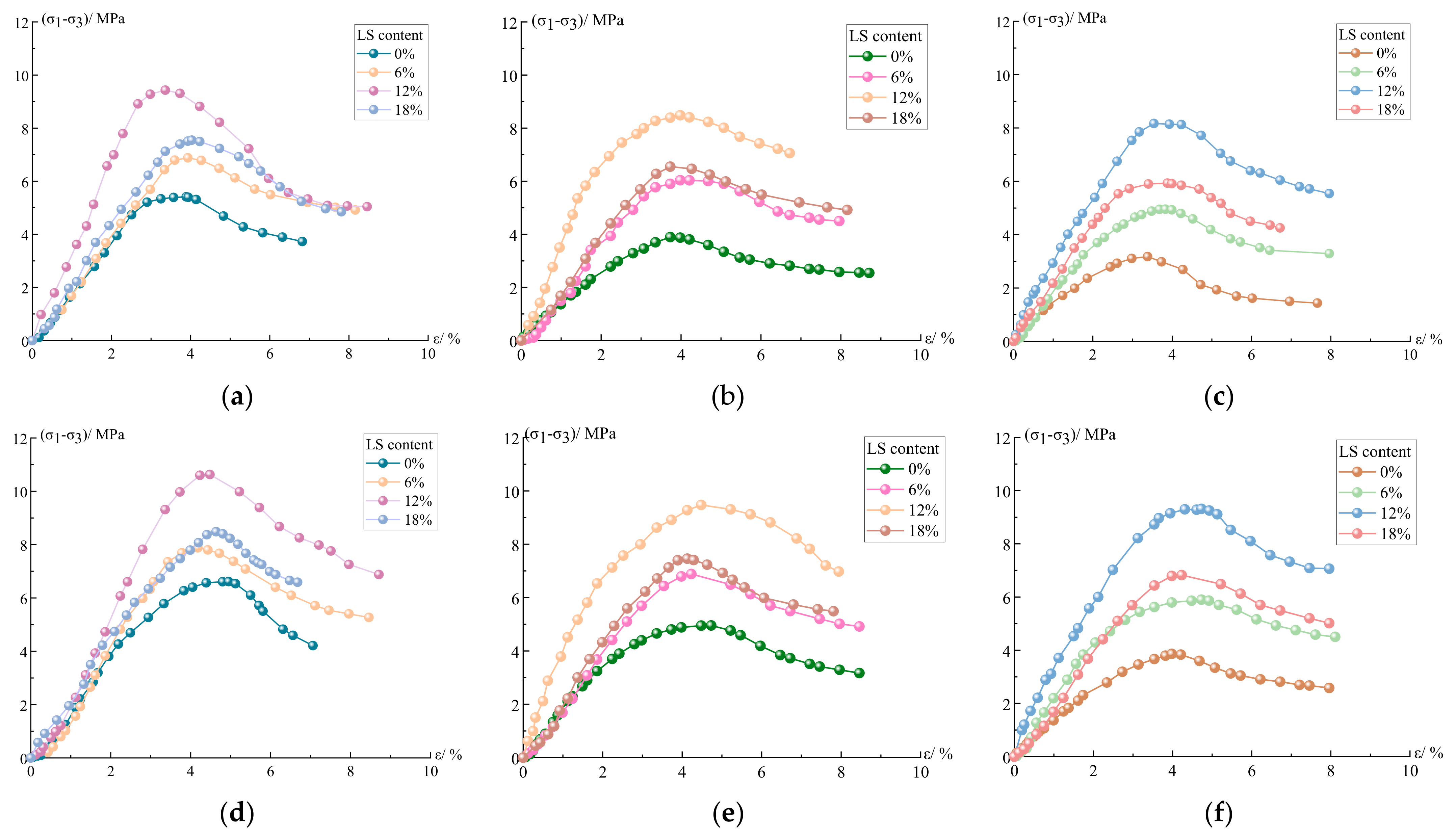


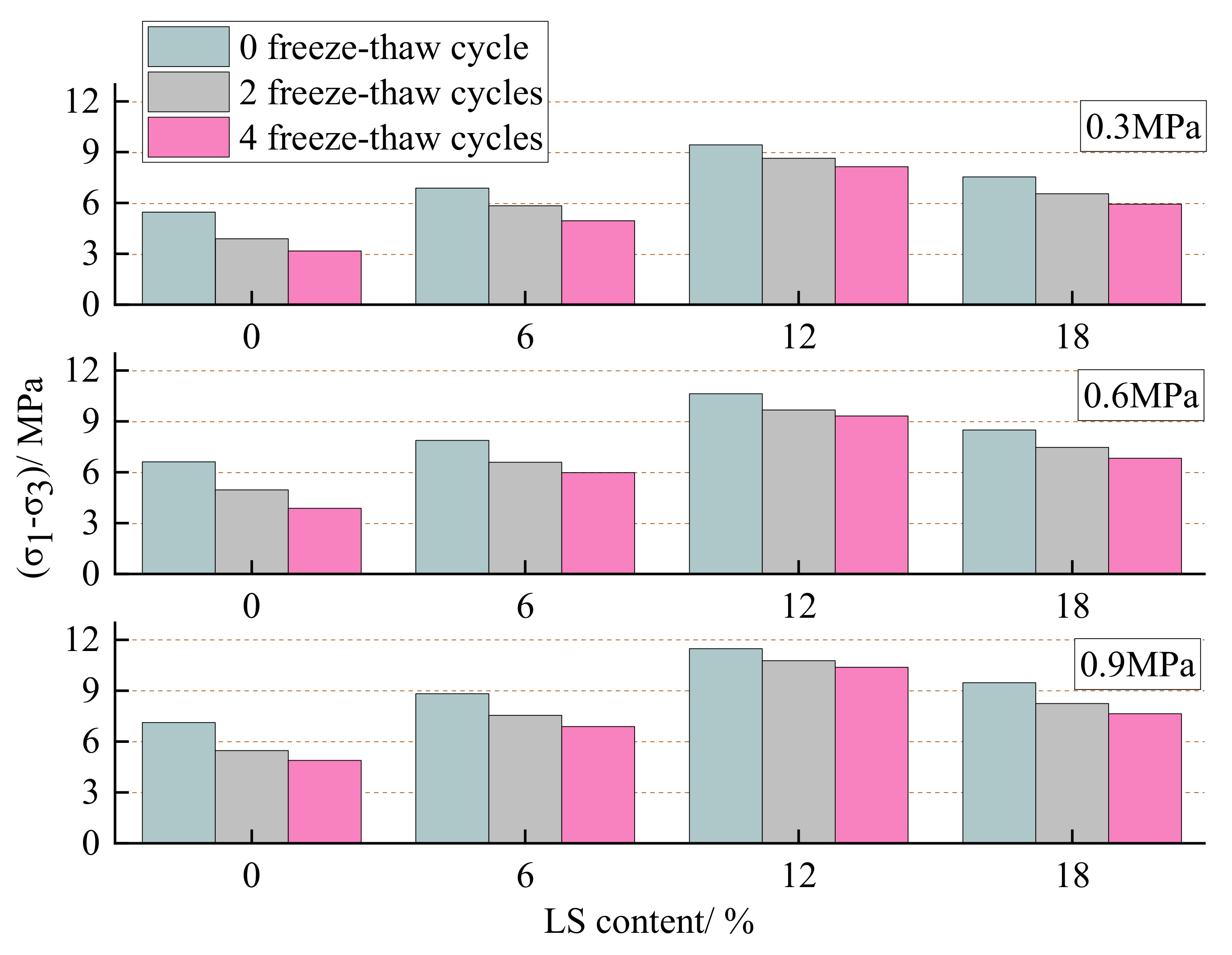
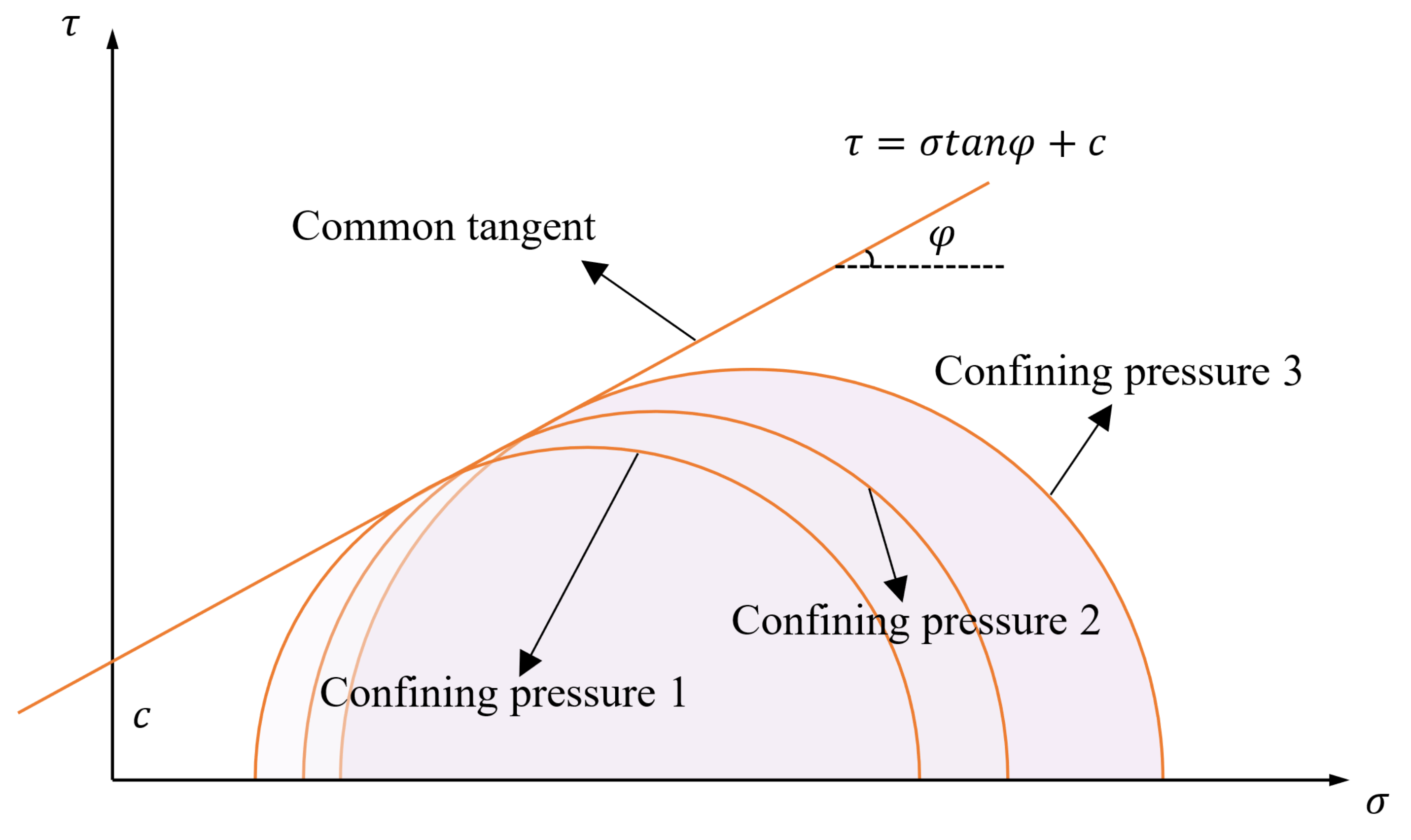
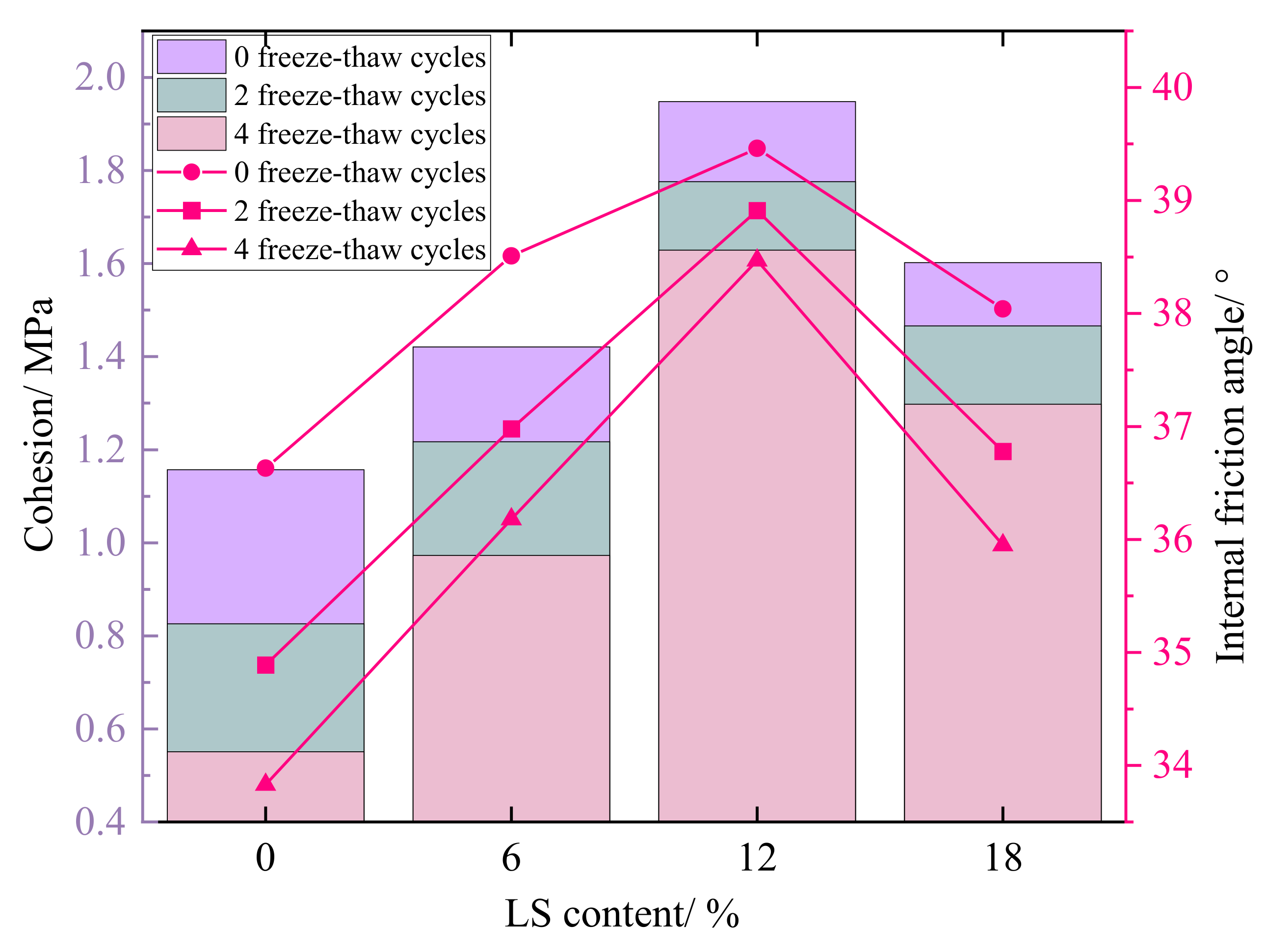

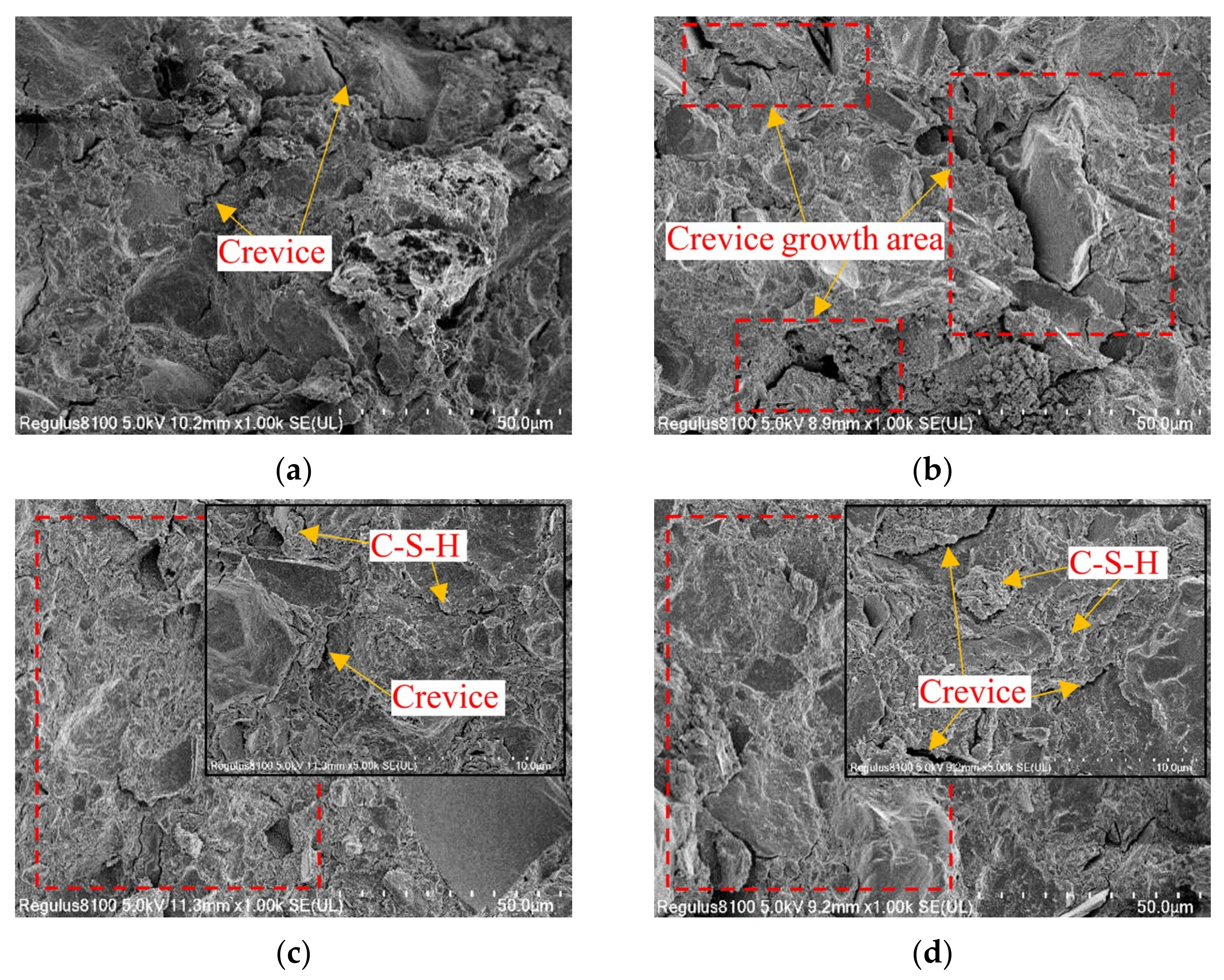

| Properties | Value |
|---|---|
| Scheme 338 | |
| Cement soundness | qualified |
| Initial setting time | 195 min |
| Final setting time | 393 min |
| 3-day compressive strength | 23.8 MPa |
| 28-day compressive strength | 37.2 MPa |
| 3-day flexural strength | 5.7 MPa |
| 28-day flexural strength | 7.2 MPa |
| Chemical Components | Cement | Lithium Slag |
|---|---|---|
| 19.17 | 56.26 | |
| 58.54 | 9.83 | |
| 7.26 | 17.39 | |
| 3.96 | 0.96 | |
| - | 1.32 | |
| 1.09 | 0.26 | |
| - | 1.21 | |
| 5.07 | 5.82 | |
| - | 0.17 | |
| Others | 3.86 | 1.13 |
| LOI a | 1.05 | 5.65 |
| Properties | Value |
|---|---|
| Natural moisture content | 27.2% |
| Natural weight | |
| Natural density | |
| Liquid limit | 33.5% |
| Plastic limit | 18.7% |
| Liquidity index | 0.56 |
| Plasticity index | 14.8 |
| Specimens | Cement | LS | Soil | Water | Water/Binder Ratio |
|---|---|---|---|---|---|
| LC-0 a | 12 | 0 | 88 | 20.4 | 1.7 |
| LC-6 | 12 | 6 | 82 | 20.4 | 1.7 |
| LC-12 | 12 | 12 | 76 | 20.4 | 1.7 |
| LC-18 | 12 | 18 | 70 | 20.4 | 1.7 |
Publisher’s Note: MDPI stays neutral with regard to jurisdictional claims in published maps and institutional affiliations. |
© 2022 by the authors. Licensee MDPI, Basel, Switzerland. This article is an open access article distributed under the terms and conditions of the Creative Commons Attribution (CC BY) license (https://creativecommons.org/licenses/by/4.0/).
Share and Cite
Chen, Z.; Chen, S.; Liu, L.; Zhou, Y. Effects of Lithium Slag on the Frost Resistance of Cement-Soil. Materials 2022, 15, 5531. https://doi.org/10.3390/ma15165531
Chen Z, Chen S, Liu L, Zhou Y. Effects of Lithium Slag on the Frost Resistance of Cement-Soil. Materials. 2022; 15(16):5531. https://doi.org/10.3390/ma15165531
Chicago/Turabian StyleChen, Zhi, Sili Chen, Liwen Liu, and Yuwan Zhou. 2022. "Effects of Lithium Slag on the Frost Resistance of Cement-Soil" Materials 15, no. 16: 5531. https://doi.org/10.3390/ma15165531






